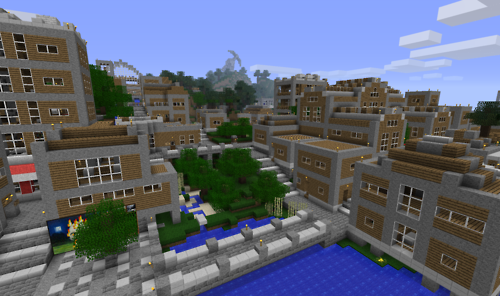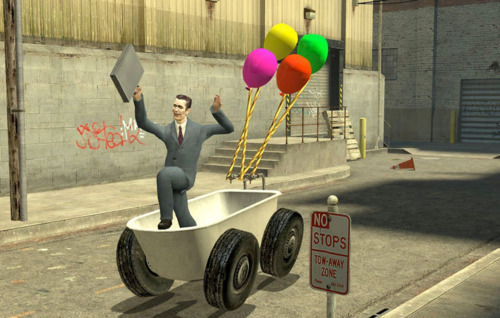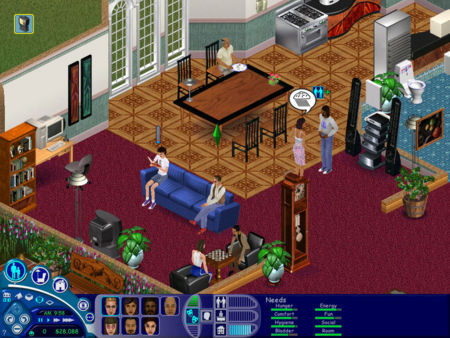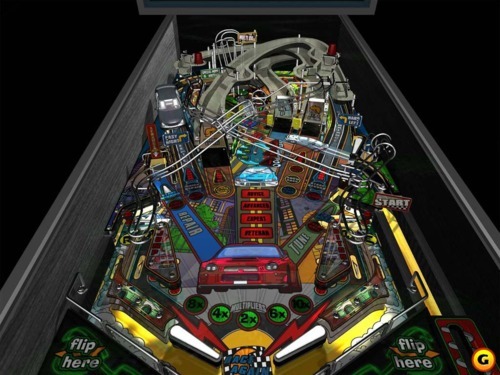Intro (the idea behind this)
In a Project with my professor Mario Doulis, we startet talking about games.
To make a long story short: We had to make up ideas for projects.
At first, I recognized the basic difference between Computer Games and Board Games: While Board Games leave the control over the games rules by the players, computer games controll the rules by themselves.
If all players of monopoly want to change the rules to their likes, the game still works. It got modified, just by the combined will of its players.
Try that in Call of Duty, for example. Even if all the players decode, that they rather wanna make exchange all weapons with fishes to throw at each other, the game just won't let them do it.
The difference from computer games to analog games ( I will use the term "analog games" for all non-digital games, like board games, card games, pen and paper, etc...) is, that the computer normally is the keeper of the rules.
My idea was, to create a concept for a computer game, that lets the users controll the rules. By this decision, innovative game concepts should become true.
For example, think of a partygame, where the computer tells you and your friends in front of the screen: "Run to the freezer and take a bottle of milk out of it. The one who returns first and presses the enter-key wins." The computer doesn't know, who pressed the key and therefore hands the power over the rules over to the players. What more game concepts would become possible like this?
This simple yet kinda fascinating idea led me to a question, which suddenly became much more important than anything else in this project: Why use a computer for this? Wouln't a piece of pronted cardboard do the job just as well as a complex machine???
This all boils down to the simple but important question:
What is the role of the computer in computer games?
On this blog, I will try to analyse the history of computer games and look into some modern games of different genres, to find our about it.
My goal is not so much to find a definitive answer to the question, but more to coin awareness of the question itself.
It should help game-designers to rethink the role of the machine in their games, to get new and exciting ideas for them.
If you want to say something about the topic, feel free to contact me: facebook.com/falkenbergdesign
Magnavox Odyssey

The Magnavox Odyssey is a very special console, regarding the role of the computer in it's games.
Everybody who doesn't knows this console, should watch these 2 videos for a short introduction about the system:
Magnavox Commercial(1973)
Irrate Gamers review of the Odyssey System
The second one is however an angry satirical review (still by far the best one).
I don't think, he knows, what exactly made this console special.
Interesting however is, how he notices that there is no point system in its games.
This really is a video game, that hands out the control over the game to the people playing it, like in board games or other "analog" games (for simplicity I will call all games, which are not considered video games analog games).
However, the lack of a point system is just a small part of the story, since this console was developed, before the paradigm, "the machine controls the rules" was settled.
Today, we might be unable to imagine, how moving a white dot over a screen, or playing a horrible bugged version of pong without rules could have been fun for the people. Back then, things werde different. Of course, you could play almost every game in an analog form ("simon says" could be just as well played with cards) and some games were just about moving a white dot over the screen. The computers role was an entirely different one, than it is in todays computer games. The machine doesn't know the rules and does also not know of the overlay, placed on top of the screen. Also, there were no counting mechanisms included with the console. The Players hat to survey the rules by themselves, like in an analog game.
Why then use a computer for it?
The answer is simple: Until 1972, there was no such thing as "tv being a democratic medium". Altough it was only a small white dot, which you could move over your TV-screen, the most interesting thing about it remains: YOU are controlling the white dot. This was propably the first time ever, that the people in front of the screen could control its content.
Of course it was possible to controll the things on your screen before, using hacks. For example by holding a magnet next to the tube, to distort the image or control the beam of light in it. Still, these techniques don't count here, since they are more provoked glitches than an intended part of the medium.
The Magnavox Odyssey was fascinating, because you could control this white dot around the screen, without having to find an exploit to the televisions technology.
Board Games in digital form
Let us now look at a very special genre of computer games, that was especially important until the end of the 90s: PC-Versions of classic Board Games.

I will show you three examples of such games:
Trivial Pursuit C64 - 1986
http://youtu.be/Vl4tZmwIsIQ
Battle Chess - 1991
http://youtu.be/OOtyn9fY844
Dr. Drago's Madcap Chase (in Germany known as "Die total verrückte Rallye")
1997
http://youtu.be/ALFQ_AsZmyI
Interesting about these games is, that they could all be played without a computer.
One special thing about it would be the possibility, to play those games alone versus the computer. Anyway, that's not what made it all so fascinating back then. It wa still much more fun to play these games against your friends, since they allowed an easy multiplayer experience on the pc without having to connect two pcs (which was much more complicated back then).

Anyway, the most fascinating thing about these games were their rich graphical experience!
I remember playing Battle Chess as a child, after having already played a lot of chess in "real life" (I hate this term, because what you do on the computer is real too. A part of your life! However, Im not very good with this language, so I cant find another word for it...).
The graphics were absolutely mindblowing! I remember having discussions about the extreme level of detail on the chess figures.
In Analog Games, a lot only works with fantasy. These 3 Games visualised what usually happened into the minds of the players. Because like that, all the players had the same images (contrary to the fantasy pictures in their heads when playing analog games). By having the same images, the players could actually laugh together over, or discuss them. This new social component in analog games conversions may be a significant point.
It's kind of like books and movies. Books as the older form of narrative challenge your imagination. Movies were and still are however fascinating, because they visualize this narration.
To bring this article to an end, we could say, that these digital board games augment their analog counterparts.
Their success relys to a big part on the enthusiasm over a new technology and their humorous conversion into a new medium.
After all, you don't NEED a computer for a game of chess, but with it, you may have a lot more fun playing the game, altough, the computer only simulates printed cardboard, plastic and wooden figures etc.

Very interesting here is by the way the fact, that in Trivial Pursuit, the Computer didn't check your answer. The machine asked you a question and told you the correct answer after a certain amount of time. After that, the game asked you, if you got it right. You could answer Yes, even you really got the answer wrong. The computer had no chance to check it.
Open World and Sandbox Games
In this Article, I will look at what the computer is doing in so called Sandbox Games.
At wikipedia, you can read more about Open world in Computer Games:
http://en.wikipedia.org/wiki/Open_world
As examples for the Genre, we will look at 3 Games:
Minecraft
http://youtu.be/ANgI2o_Jinc
http://www.minecraft.net/
Garrys Mod
http://youtu.be/fh8VfFH78jY
http://youtu.be/7zWO98ognNc
The Sims Series
http://youtu.be/jXtI9Db_xyY
http://youtu.be/SrxVF9NPPoA
These Games all simulate a complex fictional environment, in which the player can experiment. Let us now look at the three examples, which are somehow more different from each other, than the examples in the other articles.

In Minecraft, you get a limited set of possibilities, but have the freedom to make everything you can imagine out of them. The Computer controls the rules of the world. Examples are, that a cactus has to have one free block in north, east, west and south direction, or that you cannot build anything higher than 64 blocks towards the top or the bottom of the map. There are many more of this rules, like crafting. Two sticks and three bars of iron make an iron pickaxe, which gives you the ability to mine stone and minerals.
Despite the relatively controlled environment, the player has a lot to choose from. Does he play with zombies enabled? Will it be about surviving or just about building? Some people host role playing servers, where there is a finished medieval (for example) world, in which the players have to do quests, given by the administrators or other players. Then there are a lot of building servers, where it is allowed to cheat resources with console commands. On these Servers the game is not about harvesting resources, surviving or adventure, but about construction of impressive huge buildings out of blocks.
Further, these Open World Games tend to develop Games in Game.
Minecraftcommunity has invented the fictional game of "Spleef", for which huge Arenas are constructed in Game. The Players controll the rules in this Game in Game, since the Computer only simulates the world, in which the game was invented and since then got played. Since the rules are in no way controlled by the computer but only by the players, there are quite some different versions, which can be played. Every Minecraftserver (they tend to become small communities) can apply slight modifications to the rules, as it is common with lots of analog game. Just think of a card game, where in some regions a seven means, that you have to take 2 cards. There are Regions, in which the tradition of the game is rather to draw 4 cards, when "hit" by a seven. The rules vary from region to region, because they are so easy to modify. All you need for a modification of the rules in analog games is agreement over the new rules among all the players of the match.

The next Example for a Sandbox Game is Garrys Mod, or gmod:
This Game started out as a free modification to the game Halflife2 but eventually got so complex, that it was sold as a stand alone title. Yet, the connection, to the Halflife universe remains visible not only through the source-engine.
The difference to Minecraft is here, that there are nearly no restrictions in the game.
You can spawn every object from the Halflife Games in gmod and give it physical properties or attach it to something else. You could argue, that gmod has a crafting system, but it's quite different than the one found in Minecraft.
You dont combine various objects in a crafting grid for them to magically form another item, which is defined as the result of a crafting formula in the rules.
In gmod, you just give spawned objects physical properties and can now attach them in different ways to other objects, creating, for example, balljoints or axes, on which the objects can rotate freely. Watch this tutorial to see, how one would create a car in gmod:
http://youtu.be/5XuNx-PTfaM
There is even more in this game, since it has its own programming interface. Via lua-scripting, people are able to add everything they can think of as part of the game. When you log in to a multiplayer-game, the lua-scripts of the users get synchronized, so that other players can see the custom made scripts. One very special script is the wiring mod. It enables you to build some kind of electric circuits ingame, which makes extremely complex devices possible.
More than that, the game lets you spawn enemies or non player characters ingame. For those characters you can switch A.I. on and off. This makes computercontrolled zombies that try to destroy your fortress as well possible, as controlling facial expressions of "dolls" with the tools of the game. In this mode it is perfect for machinimas.
As you can imagine, these possibilities lead to an endless varieties of games, that can be played inside this simulated environment.
The fun in Minecraft and Garrys Mod is to explore the possibilities of the simulated world. In Analog games, this would not be possible like that, because the rules are so complex, that it would be no fun to keep them in mind, or if there would be a human game master involved, controlling the rules, you would have too much room for interpretations and still could not see the devices or structures actually working in this simulated environment.
So you could maybe say, it is about probing the rules of the simulated world and trying to build the best things possible in this limited environment.

Sims is maybe a little bit different here. It is also an Open World Game, but it's rules are more strict. You can't just create your own furniture or invent games ingame. The fun here lies more in the simulation of life, or in the complex possibilities to build houses, that the sims actually inhabit after you built them.
Sims provides a controlled secure social environment in which you can experiment savely. There are no consequences for your real life and nobody will ever blame you for something you do in Sims. Also, the game rewards you much faster for your virtual actions, than real life rewards you for the real ones. To grow a sixpack is a matter of minutes or at worst hours in Sims. You would need much more effort to do this in real life. This instant reaction to your actions seems to me something very important when it comes to understanding the phenomenon.
The Computers role in this game is very important. All this only works, because the people in the game behave mostly reasonable. This is also what the developers of the Sims say in an interview, linked at the top of the article.
(Here it is again, so that you don't have to scroll up: http://youtu.be/jXtI9Db_xyY?t=5m55s )
However, to explore the addictiveness of the sims, you should maybe approach the game as a psychologist. Since I am not a psychologist, I will stop at this point.
To summarize it, I would say, that sandbox games give you room to experiment with the game. A complex, yet very limited environment, in which you can safely experiment, interact with other players or try to make the best out of the gameworlds limited capabilities. These simulations are so complex, that it is impossible as far as i know, to simulate them in an analog game, without losing the joy of instant results through try and error, that the game offers.
Pinball Games

Epic Pinball (1993)
http://youtu.be/m2nsY9J_4as
Pure Pinball 2 (2005)
http://youtu.be/YbqAmCW4baE
There is something very ironic about pinball games.
Sherry Turkle wrote in the second self (in the chapter called "Video Games and Computer Holding Power") about pinball machines as something like the predecessors of arcade video games. Clearly, the computer was superior to the old pinball machines.
Yet, pinball machines were soon availible in digital form, as an own genre in computer games which eventually died in the late nineties(german text. sorry, i couldn't find an appropriate english one).
I guess, the fascination was more about havong such a machine at home, beeing able to play a huge variety of different creatively designed tables for free, as much as you want. Another reason might be nostalgia. However, if you play or played pinball games, let me know, what fascinatef/fascinates you the most about it.
As graphics became more complex the simulation got too.
Interesting about this, concerning my research is, that a cheat from the analog pinball games became a part of the ruleset of digital flippers: the TILT command.
Analog Pinball players played with theid whole body, tilting and kicking the machine, until the game stopped due to the beating of the machine (I really recommend reading "the second self" from Sherry Turkle, if you are interested in video games). The Computer tries to replicate this by adding a tilt-command, which also leads to the virtual pinball machine stopping the game, if you overdo it.
However as a child, not having played much pinball in real life, I never understood the sense behind this. You have to know, how to operate the analog counterpart of these games, to understand the tilt function.
Tilting in pinball games is not a logical part of the games rules, more the addition of a breach of rules from it's archetype.
Preliminary Conclusion
The question itself after the role of the computer in computer games cannot be answeared easily for now. I will call this a preliminary conclusion, as this series of texts is always work in progress. This conclusion shall be a "screenshot" of the knowledge around this topic so far.
The role of the computer in computer games varies strongly and there are tendencies in the history of computer games.
In the beginning, the computer itself was the game. The fascination about the new technology was so big, that it didn't need much more for people to be fascinated of it.
Shortly after, the role of the computer was to provide playgrounds, in which people could compete against each other (or together versus the computer) in new kinds of games, which have hardly been possible in real-time before.
Another very important role the computer soon took was not only the role of the gamemaster, but also the rule of the opponent in the game:
In Space Invaders, it controlled the attackers, in Donkey Kong it threw the Barrels. This all happened in real-time and didn't by far need as much imagination power as analog solitair-games.
As computers became more powerful, another aspect became stronger:
A rich graphical experience! Sometimes, the fascination about the realistic immersive experience is reason enough for a game to be played. It visualises the things, we previosly had to do in our head (imagining the few pixels in Space Invaders as attacking alien spaceships). Coin operated Arcade Games had maybe for this exact reason (to help our imagination) colorful illustrations of the games content on their cabin.
By providing realistic experience in games, they also could serve as sandboxes, in which you can try out things, that you would never do in real life, for example stealing a sportscar in GTA and racing it downtown with 120mph.
In reality, this action would likely end in the death of many people, hundreds of thousands of damage on someones property and if you somehow survive, a very long time in jail or a death sentence against you (depending on your government).
In the game, you will eventually die or be caught by the police too, but the game will just go on with you walking out of a police station, ready for another carjack (no discussion on video-game-violence here).
Some final questions:
How long will the computer still be able to improve on graphics, animation, physics, etc? How long will the fascination about this technology still be a reason to buy or play a game?
Shouldn't we rely rather on good ideas, than on the technology?
(Still) How can we develop such good ideas AND give the computer a rule, he's worthy of?
If graphics, physics, animation, etc are so good these days, is it really the right way to simulate realistic environments?
Shouldn't we use the computing power to visualize fantasy worlds, which our imagination hardly can't imagine this way?
Why are these realistic-style games so widespread and successful?
Wouldn't it be possible to involve multiple human creators or game-masters, developing the game, just as the others are playing it? The computer could serve as a platform and a tool here.
Does there even have to be a division in between game-master or creators and gamers? Can't everybody be both at the same time?







